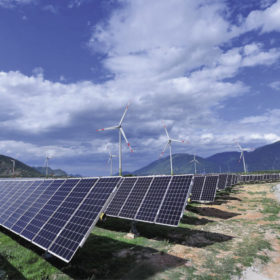
A new paper published by the U.S. National Renewable Energy Laboratory delves into the potential of hybrid power plants combining wind and solar generation. Development of such plants, according to the lab, is driven by the need to increase profitability and consider metrics beyond levelized cost of electricity, taking into account time varying revenues and better managing these renewables inherent variability.
“A paradigm shift is underway,” according to the United States National Renewable Energy Laboratory (NREL), “With renewable energy growing to 10%–20% or more of overall electricity generation, design objectives are shifting from producing energy at the lowest levelized cost of energy (LCOE) to also include other design objectives that maximize profitability.
A paper published by NREL, Research Opportunities in the Physical Design Optimization of Hybrid Power Plants, examines the opportunity this move beyond LCOE provides for hybrid renewable energy systems, particularly those combining wind and solar generation.
As feed in tariffs and other incentives are reduced, renewables are increasingly left to compete with conventional energy sources and develop alternate revenue sources that consider time varying generation, capacity and ancillary services. And this requirement for variable renewables to behave more like conventional energy assets could be met by combining solar, wind and other renewable generation assets, plus energy storage, into hybrid systems, says NREL:
“By combining generation assets together, including storage, solar, and wind, into “hybrid power plants,” an individual plant owner can 1) develop economies of scope in terms of land usage, electrical and physical infrastructure, and operational expenditures; and 2) increase their system value to capitalize on revenue streams through forward capacity markets (where present), “dispatchable” operation in markets with time-varying energy pricing, and ancillary service markets (where present).” – Katherine Dykes et al, 2019.
The report, which is available free of charge from NREL’s website, examines the opportunity for such hybrid systems to participate in both existing market structures, and new ones that are evolving as a consequence of higher grid penetration by variable renewables, and looks into optimal system designs to take advantage of this.
The biggest factor identified for system design is characterization of the energy resources and their joint distribution over time, and it is noted that market structure is a source of uncertainty – with most plants being design with a PPA type structure in mind, where LCOE optimizations are the key consideration.
NREL notes that such an approach would not likely be optimal in terms of profitability, and suggests alternatives that might better take into account the characteristics of both the energy resources and the market into which the system is dispatching electricity, noting that further research into this optimization is needed.
“The complexity and uncertainty involved in the physical design optimization of hybrid power plants goes beyond current practice,” reads the conclusion of the report, “…and creates opportunity for research and innovation to realize the full potential of future hybrid power plants with low cost and high value to the electric grid system.”
Lắp đặt điện mặt trời Khải Minh Tech
https://ift.tt/2X7bF6x
0906633505
info.khaiminhtech@gmail.com
80/39 Trần Quang Diệu, Phường 14, Quận 3
Lắp đặt điện mặt trời Khải Minh Tech
https://ift.tt/2ZH4TRU
Không có nhận xét nào:
Đăng nhận xét